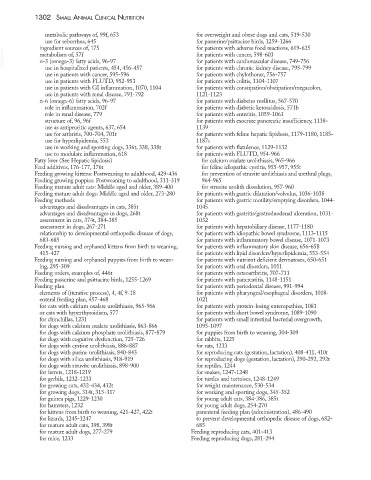Page 1250 - Small Animal Clinical Nutrition 5th Edition
P. 1250
1302 SMALL ANIMAL CLINICAL NUTRITION
metabolic pathways of, 99f, 653 for overweight and obese dogs and cats, 519-530
use for seborrhea, 645 for passerine/psittacine birds, 1259-1266
ingredient sources of, 175 for patients with adverse food reactions, 619-625
VetBooks.ir metabolism of, 57f for patients with cancer, 598-603
n-3 (omega-3) fatty acids, 96-97
for patients with cardiovascular disease, 749-756
use in hospitalized patients, 454, 456-457 for patients with chronic kidney disease, 795-799
use in patients with cancer, 595-596 for patients with chylothorax, 756-757
use in patients with FLUTD, 952-953 for patients with colitis, 1104-1107
use in patients with GI inflammation, 1070, 1104 for patients with constipation/obstipation/megacolon,
use in patients with renal disease, 791-792 1121-1123
n-6 (omega-6) fatty acids, 96-97 for patients with diabetes mellitus, 567-570
role in inflammation, 702f for patients with diabetic ketoacidosis, 571b
role in renal disease, 779 for patients with enteritis, 1059-1061
structure of, 96, 96f for patients with exocrine pancreatic insufficiency, 1138-
use as antipruritic agents, 637, 654 1139
use for arthritis, 700-704, 701t for patients with feline hepatic lipidosis, 1179-1180, 1185-
use for hyperlipidemia, 553 1187c
use in working and sporting dogs, 336t, 338, 338t for patients with flatulence, 1129-1132
use to modulate inflammation, 618 for patients with FLUTD, 954-966
Fatty liver (See Hepatic lipidosis) for calcium oxalate urolithiasis, 965-966
Feed additives, 176-177, 176t for feline idiopathic cystitis, 955-957, 955t
Feeding growing kittens: Postweaning to adulthood, 429-436 for prevention of struvite urolithiasis and urethral plugs,
Feeding growing puppies: Postweaning to adulthood, 311-319 964-965
Feeding mature adult cats: Middle aged and older, 389-400 for struvite urolith dissolution, 957-960
Feeding mature adult dogs: Middle aged and older, 273-280 for patients with gastric dilatation/volvulus, 1036-1038
Feeding methods for patients with gastric motility/emptying disorders, 1044-
advantages and disadvantages in cats, 385t 1045
advantages and disadvantages in dogs, 268t for patients with gastritis/gastroduodenal ulceration, 1031-
assessment in cats, 374t, 384-385 1032
assessment in dogs, 267-271 for patients with hepatobiliary disease, 1177-1180
relationship to developmental orthopedic disease of dogs, for patients with idiopathic bowel syndrome, 1113-1115
683-685 for patients with inflammatory bowel disease, 1071-1073
Feeding nursing and orphaned kittens from birth to weaning, for patients with inflammatory skin disease, 656-658
415-427 for patients with lipid disorders/hyperlipidemia, 553-554
Feeding nursing and orphaned puppies from birth to wean- for patients with nutrient deficient dermatoses, 650-651
ing, 295-309 for patients with oral disorders, 1011
Feeding orders, examples of, 446t for patients with osteoarthritis, 707-711
Feeding passerine and psittacine birds, 1255-1269 for patients with pancreatitis, 1148-1151
Feeding plan for patients with periodontal disease, 991-994
elements of (iterative process), 4, 4f, 9-18 for patients with pharyngeal/esophageal disorders, 1018-
enteral feeding plan, 457-468 1021
for cats with calcium oxalate urolithiasis, 965-966 for patients with protein-losing enteropathies, 1081
or cats with hyperthyroidism, 577 for patients with short bowel syndrome, 1089-1090
for chinchillas, 1231 for patients with small intestinal bacterial overgrowth,
for dogs with calcium oxalate urolithiasis, 863-866 1095-1097
for dogs with calcium phosphate urolithiasis, 877-879 for puppies from birth to weaning, 304-309
for dogs with cognitive dysfunction, 725-726 for rabbits, 1225
for dogs with cystine urolithiasis, 886-887 for rats, 1233
for dogs with purine urolithiasis, 840-843 for reproducing cats (gestation, lactation), 408-411, 410t
for dogs with silica urolithiasis, 918-919 for reproducing dogs (gestation, lactation), 290-292, 292t
for dogs with struvite urolithiasis, 898-900 for reptiles, 1244
for ferrets, 1218-1219 for snakes, 1247-1248
for gerbils, 1232-1233 for turtles and tortoises, 1248-1249
for growing cats, 432-434, 432t for weight maintenance, 530-534
for growing dogs, 314t, 315-317 for working and sporting dogs, 345-352
for guinea pigs, 1229-1230 for young adult cats, 384-386, 385t
for hamsters, 1232 for young adult dogs, 254-270
for kittens from birth to weaning, 421-427, 422t parenteral feeding plan (administration), 486-490
for lizards, 1245-1247 to prevent developmental orthopedic disease of dogs, 682-
for mature adult cats, 398, 398t 685
for mature adult dogs, 277-279 Feeding reproducing cats, 401-413
for mice, 1233 Feeding reproducing dogs, 281-294

